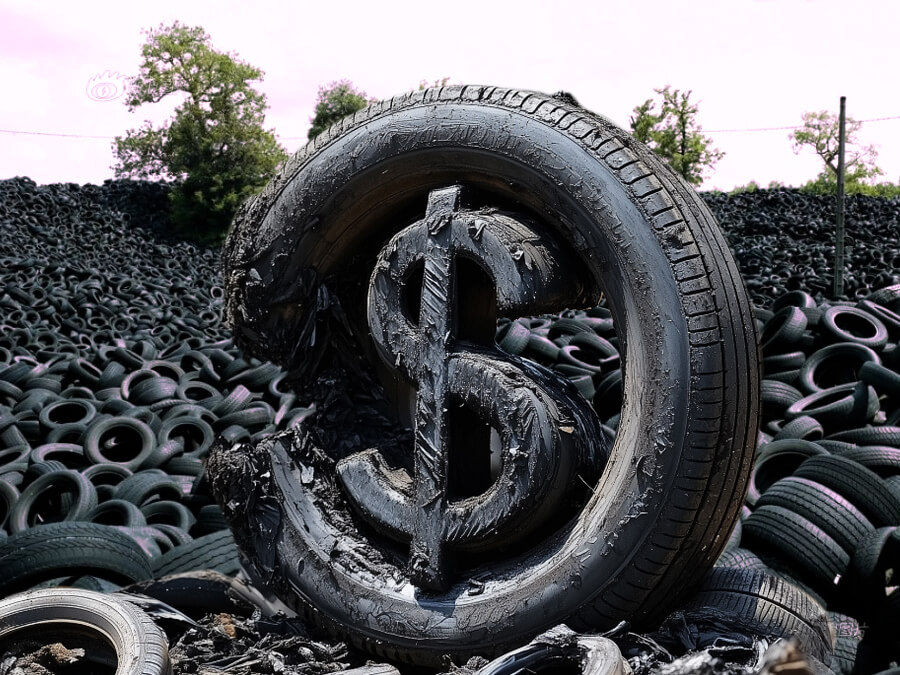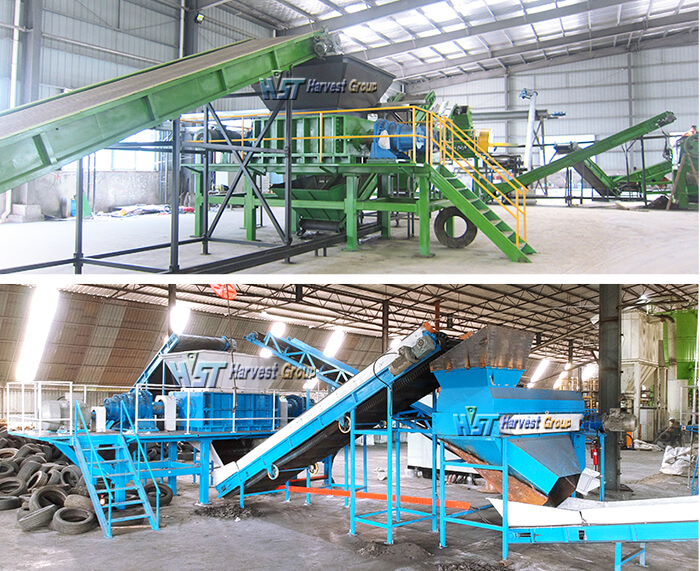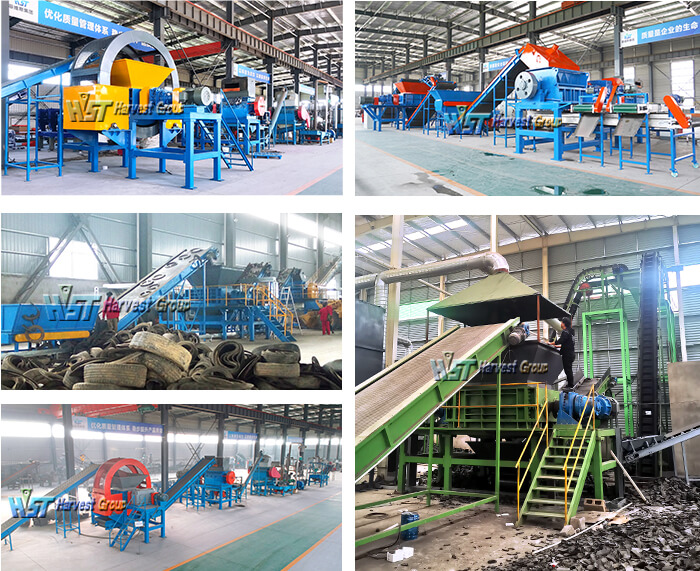China discards over 290 million tires annually. These “black rubber giants” removed from their rims pile up in mountains, not only occupying vast amounts of land resources but also posing environmental challenges due to their difficulty in natural degradation. However, driven by environmental pressure and circular economy policies, this massive figure hides a trillion-dollar blue ocean market opportunity.
Looking back at the industry’s development trajectory, from the late 1980s to the early 1990s, due to outdated recycling technology and limited environmental awareness, China’s tire recycling rate remained stagnant at a low 11%. At that time, most waste tires were either left exposed outdoors or simply buried, not only breeding mosquitoes and spreading pathogens but also causing residual chemicals to continuously pollute soil and groundwater. It wasn’t until after the year 2000, with breakthroughs in key technologies such as thermal cracking and fine rubber powder production, along with the introduction of policies like the “Guidelines for the Comprehensive Utilization of Waste Tires,” that the industry experienced explosive growth. By 2017, the recycling rate of waste tires had surged to 81.4%, successfully transforming “black pollution” into high-value-added products such as recycled rubber, rubber powder, and tire-derived fuel.
Despite significant progress, the industry still faces structural challenges: most recycled resource processing companies are small in scale, core technologies such as high-end rubber powder and environmentally friendly pyrolysis equipment rely on imports, and some regions still have illegal burning and landfilling practices. This means that, amid the ongoing release of policy benefits and accelerated technological innovation, the tire recycling industry still holds immense untapped value.

Engaging in tire recycling not only effectively alleviates the ecological pressure on landfills but also holds immense commercial potential. According to statistics, approximately 1.5 billion used tires are generated globally each year, with a significant portion being directly landfilled or incinerated. This not only occupies valuable land resources but also releases toxic gases, causing severe environmental pollution. Through professional recycling and processing, these waste tires are transformed into high-value resources: Tire-derived fuel (TDF) can replace coal in industrial production such as cement kilns, with combustion calorific value comparable to coal but lower sulfur content; Rubber particles, after精细加工, are widely used in applications such as synthetic running tracks and artificial turf, with strong market demand; Steel wires from tires, after sorting and processing, can be reintroduced into the metallurgical cycle as high-quality steel raw materials. In recent years, with the tightening of environmental policies and the enhancement of awareness of resource recycling, the annual output value of the tire recycling and processing industry has been growing at an average annual rate of 12%, achieving green development while also opening up a sustainable profit path for entrepreneurs.
Clearly understand the demand for recycled tire products in your region. Different industries have varying demands for recycled tire products, such as the construction industry, power plants, and amusement parks, which could all be potential demand sources. Additionally, pay attention to export opportunities within the region and understand the demand for recycled tire products in surrounding areas or countries.
Conduct in-depth research on local and neighboring competitors to understand their business scope, product features, pricing strategies, and target customers. Through analysis, identify gaps in the market, such as whether there is an underserved TDF market or a lack of rubber granule suppliers, which could serve as entry points for your business.
Map out potential tire suppliers, such as auto repair shops, car dealerships, and landfills, which are common sources of tires. To reduce transportation costs, ensure suppliers are located within 150 miles of your business location to minimize time and expense during transportation.
Conduct thorough research into local, state, and federal laws and regulations, such as Environmental Protection Agency (EPA) permitting requirements and waste management regulations. Additionally, familiarize yourself with regional programs like Australia’s National Tire Product Stewardship Program to ensure your operations comply with all relevant regulations.
Prioritize locations easily accessible to suppliers and customers, with proximity to transportation hubs to reduce logistics costs. Ensure a stable supply of electricity and water, as tire recycling machinery has high demands for both. Additionally, confirm that the selected site has obtained the necessary permits; suburban areas are often ideal due to lower land costs.
For a tire collection center, at least two workers are required; for a tire processing plant, which involves loading/unloading, machinery operation, and monitoring, approximately ten or more workers are needed.
The business plan should outline the company’s structure, management team, products or services, marketing strategies, and financial projections. These elements are critical for securing funding from investors or lenders and also guide the company’s daily operations.
The business plan should include information on service content, pricing, service locations, ordering methods, payment terms, delivery times, how to inquire about tire recycling status, recommendations for disposing of used tires, the benefits of recycling tires, and the company’s contributions to the environment, thereby building customer trust.
Detail costs related to land, equipment, and labor, and develop a funding plan to meet the capital requirements of this capital-intensive project. Funding can be secured through loans, attracting investors, or applying for grants.
As a key node in achieving the resource utilization of discarded tires, the business scope of a used tire recycling plant covers all categories of products, including passenger car tires, heavy-duty truck tires, and industrial specialty tires. Relying on a specialized equipment system and systematic process flow, the recycling plant can dismantle and process discarded tires, converting them into high-value-added recycled materials, thereby establishing a complete resource recycling chain.
Tire recycling and processing is a highly precise and systematic production process, with each stage requiring specialized equipment to work in tandem to maximize resource recovery efficiency and economic value. The specific equipment is detailed below:
As the first step in the recycling process, the tire cutting machine uses its powerful cutting capability to precisely separate the thick rubber from the tire sidewalls, cutting them into regular ring-shaped components. This process effectively reduces the physical strength and volume of the tires, laying a solid foundation for subsequent processing stages.
After being processed by the tire ring cutter, the tire components are further processed into long, narrow rubber strips by the strip cutter. This process significantly increases the surface area of the rubber material, providing more favorable conditions for subsequent component separation processes and effectively improving separation efficiency and processing results.
The slicing machine cuts the rubber strips into uniformly thick slices, ensuring the material specifications meet the feed requirements of the rubber crusher, thereby creating the necessary conditions for precise crushing.
The rubber crusher uses high-intensity mechanical force to crush the rubber slices into directly usable rubber particles. These particles can not only serve as raw materials for rubber product production but also have broad applications in fields such as asphalt modification, possessing significant market application value.
Reinforcing fibers (such as nylon and polyester) in tires are key materials that provide structural strength and toughness. The fiber separator combines mechanical separation and electrostatic adsorption technology to precisely extract these fiber materials, enabling their secondary application value in textiles, composite materials, and other fields.
For steel cord wires that provide structural support in tires, the magnetic separator utilizes high-intensity magnetic field adsorption principles to rapidly achieve efficient separation of steel wires from other materials. Recycled steel wires are reprocessed through remelting and can be reintroduced into steel product production processes, forming a complete resource recycling system.
The transportation and equipment maintenance system is a crucial support for ensuring the efficient operation of recycling operations. Specialized transport vehicles are responsible for collecting used tires from automotive repair companies, tire sales outlets, and waste disposal institutions. Additionally, basic maintenance tools such as wrenches, screwdrivers, and pliers are provided for daily equipment maintenance and emergency repairs, minimizing downtime and enhancing overall operational efficiency.
Tire-derived fuel (TDF): A high-calorific alternative fuel produced through crushing and processing, suitable for high-energy-consuming equipment such as cement kilns and industrial boilers. Its combustion calorific value is comparable to that of traditional fossil fuels. While effectively alleviating the pressure of solid waste landfilling, it requires配套完善环保处理设施 to strictly control pollutant emissions during combustion.
Tire-derived aggregate (TDA): A granular aggregate produced through a special processing technique, featuring lightweight, high elasticity, and strong corrosion resistance. It is widely used in municipal engineering applications such as retaining wall backfill (reducing structural load), slope reinforcement (enhancing soil stability), and road base paving (absorbing vibrations and extending road lifespan).
Rubber particles: Rubber particles of different particle sizes produced through a fine grinding process. Due to their excellent shock absorption, anti-slip, and wear-resistant properties, they are widely used in the manufacturing of products such as safety mats for children’s play areas, elastic layers for professional sports fields, traffic speed bumps, and rubber flooring.
Metal and fiber materials: Steel wire cords and nylon fibers separated and purified, which are high-quality raw materials for industrial production. Steel wires can be used in automotive parts manufacturing and mechanical processing, while nylon fibers can serve as raw materials for plastic products, textiles, and recycled fiber materials, enabling efficient resource recycling.
Market Segmentation Strategy
Given the high upfront costs associated with equipment procurement, land acquisition, and labor hiring in the used tire recycling business, it is recommended that companies avoid blind diversification during the initial stages of business operations and instead focus on niche markets with strong demand and relatively low competition. Potential target customer groups should prioritize public utility companies, construction firms, sports facility builders, and related manufacturing enterprises.
We have 20 years experience in manufacturing tire recycling machine
We have 20 years experience in manufacturing tire recycling machine,Transform Waste Tire into Worth With HARVEST! Get waste tire recycling systems designed to save you costs and maximize efficiency. Our professional team is standing by to offer you comprehensive services from design to training.Get a Free Quote Now!



Most recycled rubber is not used for playground equipment as people might imagine; in fact, most of it is used as tire-derived fuel (TDF). However, if there are no paper mills or cement plants nearby, the demand for TDF may be low. Therefore, it is important to thoroughly research the local market and identify a suitable niche. Target customers can include utility companies, construction contractors, and manufacturers, among others. Products like rubber granules are often used to manufacture alternatives to wood, asphalt, or plastic.
Utilize various platforms such as social media and print media for marketing activities. Research competitors’ marketing strategies and highlight your unique selling points, such as environmental friendliness and reliability, to attract target customers.
Like other businesses, you must complete business registration, obtain an Employer Identification Number (EIN), open a business bank account, and purchase insurance. Additionally, tire recycling centers require land use permits, Environmental Protection Agency (EPA) permits, waste management facility permits, fire permits, and more. Different states may have varying recycling regulations; consult local state or federal offices for detailed information.
To protect employee safety and business investments, sufficient insurance should be purchased to address potential accidents.
Tire recycling businesses can bring positive change to communities while contributing to environmental protection. Thorough market research and careful planning are essential before launching. With the right tools and resources, success is achievable. Follow these recommendations to start your business and continue with ongoing marketing efforts.